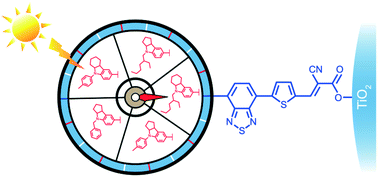Structural features of indoline donors in D–A-π-A type organic sensitizers for dye-sensitized solar cells†
Abstract
We report three newly synthesized D-A-π-A metal-free organic sensitizers for dye-sensitized solar cells (DSSCs) based on benzo[c][1,2,5]thiadiazole as an internal acceptor (A) and N-substituted indolines fused with cyclopentane or cyclohexane as donor (D) building block. Optical and photovoltaic properties of the new MAX series dyes and solar cells based on them were considered in comparison with our previously-reported dye MAX114 and well-known dye WS-2. The effect of replacing the cyclopentane ring with a cyclohexane one, as well as a substituent at the nitrogen atom of the donor fragment (aromatic p-tolyl, non-aromatic benzyl and aliphatic 2-ethylhexyl) on the position of absorption maxima in UV/vis spectra, the EHOMO and ELUMO values of MAX series sensitizers and photocurrent density–voltage trends of the corresponding solar cells were studied. It was shown that the MAX157 dye with a 9-(2-ethylhexyl)-2,3,4,4a,9,9a-hexahydro-1H-carbazole donor fragment has a shorter-wavelength absorption maximum in the intra-molecular charge transfer absorption band with the largest molar extinction coefficient in comparison with the other dyes studied. The same dye applied to the TiO2 surface showed broader optical absorption compared to other dyes in the MAX series. All dyes have a relatively narrow HOMO–LUMO gap (1.80–1.90 eV). Amongst the series, DSSCs based on MAX157 dye recorded the best power conversion efficiency (PCE) of 5.2%, which increased to 5.8% when co-sensitized with SQ2 dye. All MAX dyes reached PCEs varying between 4.4–5.2%, superior to the reference WS-2 dye (3.6%).



 Please wait while we load your content...
Please wait while we load your content...